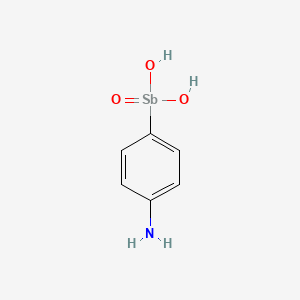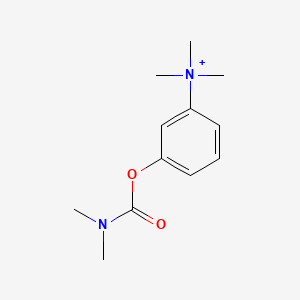
Procarbazine
描述
准备方法
合成路线和反应条件: 丙卡巴肼的合成涉及从对甲苯醛开始的几个步骤。该过程包括添加二溴氰尿酸和异丙胺以获得甲苯基异丙胺。然后将此中间体溶解在有机试剂中,然后加入N-溴代琥珀酰亚胺和引发剂。将混合物加热至回流,然后除去溶剂。加入乙腈和水解加速剂,并将混合物加热至回流以形成甲酰基苯甲酰异丙基胺。 最后,将甲酰基苯甲酰异丙基胺与甲基肼硫酸盐和三乙胺反应,然后加入氰基硼氢化钠,形成丙卡巴肼 .
工业生产方法: 丙卡巴肼的工业生产遵循类似的合成路线,但针对更高的产量和效率进行了优化。该工艺避免使用强氧化剂和强酸,使其更环保。 工业方法的总回收率约为52.9% .
化学反应分析
反应类型: 丙卡巴肼经历各种化学反应,包括氧化,还原和取代。一个值得注意的反应是其自动氧化形成偶氮衍生物,然后异构化为腙。 这种腙会发生水解,生成苯甲醛衍生物和甲基肼 .
常用试剂和条件: 丙卡巴肼反应中使用的常用试剂包括N-溴代琥珀酰亚胺,乙腈,水解加速剂,甲基肼硫酸盐和氰基硼氢化钠 . 反应条件通常涉及加热至回流和使用有机溶剂。
主要产品: 丙卡巴肼反应形成的主要产物包括苯甲醛衍生物和甲基肼 .
科学研究应用
丙卡巴肼在科学研究中具有广泛的应用,特别是在化学,生物学,医学和工业领域。 在医学上,它被用作治疗霍奇金淋巴瘤和脑癌的联合化疗方案的一部分 . 在化学中,丙卡巴肼因其独特的烷化特性及其与各种纳米结构的相互作用而被研究,用于药物递送系统 . 在生物学中,它被用于研究烷化剂对细胞过程和DNA合成的影响 . 工业应用包括其在合成其他药物化合物中的应用,以及其在开发环保生产方法中的作用 .
作用机制
丙卡巴肼的精确作用机制尚不清楚。 已知它通过干扰甲硫氨酸的甲基转移到转移RNA中,从而抑制蛋白质,RNA和DNA的合成 . 丙卡巴肼也作为烷化剂,在O-6位甲基化鸟嘌呤,导致DNA断裂并抑制RNA和蛋白质合成 .
相似化合物的比较
类似化合物: 与丙卡巴肼类似的化合物包括达卡巴嗪,博来霉素和纳武利尤单抗 . 这些化合物也用于治疗各种癌症,并具有与烷化剂或抗肿瘤剂相似的作用机制。
独特性: 丙卡巴肼的独特之处在于它可以与其他化疗药物(如氮芥,长春碱和泼尼松)联合使用,用于治疗霍奇金淋巴瘤 . 它在与纳米结构的相互作用方面也独树一帜,用于药物递送系统,这增强了其靶向癌细胞的有效性 .
属性
IUPAC Name |
4-[(2-methylhydrazinyl)methyl]-N-propan-2-ylbenzamide | |
|---|---|---|
| Source | PubChem | |
| URL | https://pubchem.ncbi.nlm.nih.gov | |
| Description | Data deposited in or computed by PubChem | |
InChI |
InChI=1S/C12H19N3O/c1-9(2)15-12(16)11-6-4-10(5-7-11)8-14-13-3/h4-7,9,13-14H,8H2,1-3H3,(H,15,16) | |
| Source | PubChem | |
| URL | https://pubchem.ncbi.nlm.nih.gov | |
| Description | Data deposited in or computed by PubChem | |
InChI Key |
CPTBDICYNRMXFX-UHFFFAOYSA-N | |
| Source | PubChem | |
| URL | https://pubchem.ncbi.nlm.nih.gov | |
| Description | Data deposited in or computed by PubChem | |
Canonical SMILES |
CC(C)NC(=O)C1=CC=C(C=C1)CNNC | |
| Source | PubChem | |
| URL | https://pubchem.ncbi.nlm.nih.gov | |
| Description | Data deposited in or computed by PubChem | |
Molecular Formula |
C12H19N3O | |
| Source | PubChem | |
| URL | https://pubchem.ncbi.nlm.nih.gov | |
| Description | Data deposited in or computed by PubChem | |
Related CAS |
366-70-1 (mono-hydrochloride) | |
| Record name | Procarbazine [INN:BAN] | |
| Source | ChemIDplus | |
| URL | https://pubchem.ncbi.nlm.nih.gov/substance/?source=chemidplus&sourceid=0000671169 | |
| Description | ChemIDplus is a free, web search system that provides access to the structure and nomenclature authority files used for the identification of chemical substances cited in National Library of Medicine (NLM) databases, including the TOXNET system. | |
DSSTOX Substance ID |
DTXSID4021189 | |
| Record name | Procarbazine | |
| Source | EPA DSSTox | |
| URL | https://comptox.epa.gov/dashboard/DTXSID4021189 | |
| Description | DSSTox provides a high quality public chemistry resource for supporting improved predictive toxicology. | |
Molecular Weight |
221.30 g/mol | |
| Source | PubChem | |
| URL | https://pubchem.ncbi.nlm.nih.gov | |
| Description | Data deposited in or computed by PubChem | |
Physical Description |
Solid | |
| Record name | Procarbazine | |
| Source | Human Metabolome Database (HMDB) | |
| URL | http://www.hmdb.ca/metabolites/HMDB0015299 | |
| Description | The Human Metabolome Database (HMDB) is a freely available electronic database containing detailed information about small molecule metabolites found in the human body. | |
| Explanation | HMDB is offered to the public as a freely available resource. Use and re-distribution of the data, in whole or in part, for commercial purposes requires explicit permission of the authors and explicit acknowledgment of the source material (HMDB) and the original publication (see the HMDB citing page). We ask that users who download significant portions of the database cite the HMDB paper in any resulting publications. | |
Solubility |
In water, 1,400 mg/L @ 25 °C /Estimated/, 2.28e-01 g/L | |
| Record name | Procarbazine | |
| Source | DrugBank | |
| URL | https://www.drugbank.ca/drugs/DB01168 | |
| Description | The DrugBank database is a unique bioinformatics and cheminformatics resource that combines detailed drug (i.e. chemical, pharmacological and pharmaceutical) data with comprehensive drug target (i.e. sequence, structure, and pathway) information. | |
| Explanation | Creative Common's Attribution-NonCommercial 4.0 International License (http://creativecommons.org/licenses/by-nc/4.0/legalcode) | |
| Record name | PROCARBAZINE | |
| Source | Hazardous Substances Data Bank (HSDB) | |
| URL | https://pubchem.ncbi.nlm.nih.gov/source/hsdb/3250 | |
| Description | The Hazardous Substances Data Bank (HSDB) is a toxicology database that focuses on the toxicology of potentially hazardous chemicals. It provides information on human exposure, industrial hygiene, emergency handling procedures, environmental fate, regulatory requirements, nanomaterials, and related areas. The information in HSDB has been assessed by a Scientific Review Panel. | |
| Record name | Procarbazine | |
| Source | Human Metabolome Database (HMDB) | |
| URL | http://www.hmdb.ca/metabolites/HMDB0015299 | |
| Description | The Human Metabolome Database (HMDB) is a freely available electronic database containing detailed information about small molecule metabolites found in the human body. | |
| Explanation | HMDB is offered to the public as a freely available resource. Use and re-distribution of the data, in whole or in part, for commercial purposes requires explicit permission of the authors and explicit acknowledgment of the source material (HMDB) and the original publication (see the HMDB citing page). We ask that users who download significant portions of the database cite the HMDB paper in any resulting publications. | |
Vapor Pressure |
8.4X10-7 mm Hg @ 25 °C /Estimated/ | |
| Record name | PROCARBAZINE | |
| Source | Hazardous Substances Data Bank (HSDB) | |
| URL | https://pubchem.ncbi.nlm.nih.gov/source/hsdb/3250 | |
| Description | The Hazardous Substances Data Bank (HSDB) is a toxicology database that focuses on the toxicology of potentially hazardous chemicals. It provides information on human exposure, industrial hygiene, emergency handling procedures, environmental fate, regulatory requirements, nanomaterials, and related areas. The information in HSDB has been assessed by a Scientific Review Panel. | |
Mechanism of Action |
The precise mode of cytotoxic action of procarbazine has not been clearly defined. There is evidence that the drug may act by inhibition of protein, RNA and DNA synthesis. Studies have suggested that procarbazine may inhibit transmethylation of methyl groups of methionine into t-RNA. The absence of functional t-RNA could cause the cessation of protein synthesis and consequently DNA and RNA synthesis. In addition, procarbazine may directly damage DNA. Hydrogen peroxide, formed during the auto-oxidation of the drug, may attack protein sulfhydryl groups contained in residual protein which is tightly bound to DNA., Procarbazine is an alkylating agent. The exact mechanism of antineoplastic action is unknown but is thought to resemble that of the alkylating agents; procarbazine is cell cycle-specific for the S phase of cell division. Procarbazine is thought to inhibit DNA, RNA, and protein synthesis., O-6-Methylguanine was measured in blood leukocyte DNA of seven patients with Hodgkin's or non-Hodgkin's lymphoma during therapeutic exposure to procarbazine involving three daily p.o. doses (50 mg each) for 10 days (corresponding to 2.1 mg/kg/day for a 70-kg human). Adduct accumulation was observed in all seven cases, reaching levels up to 0.28 fmol/microgram of DNA (0.45 umol/mol of guanine). In one individual, maximal levels of adduct were reached after 7 days of exposure, followed by a steady decline, whereas in all other individuals continuous accumulation was observed throughout the exposure period. In four individuals for which data were available for day 11 (12 to 16 hr after the final intake of procarbazine), decreased amounts of O-6-methylguanine were observed relative to the last previous measurements. The accumulation of O-6-methylguanine was linearly correlated with the cumulative dose of procarbazine, with a slope of 0.011 fmol of O-6-methylguanine/microgram of DNA per mg/kg of body weight or 2.68x10-4 fmol of O-6-methylguanine DNA per mg/sq m. Two hr after the administration of single p.o. doses of l to 10 mg/kg of procarbazine to rats, O-6-methylguanine formation in leukocyte DNA was just under half that in liver DNA and showed a linear relationship with dose with a slope of 0.017 fmol/microgram of DNA per mg/kg of body weight or 5.67x10-4 fmol of O-6-methylguanine/microgram of DNA per mg/sq m. A negative correlation between the rate of accumulation of O-6-methylguanine in different individuals and lymphocyte O-6-alkylguanine-DNA alkyltransferase was observed, demonstrating a probable protective effect of O-6-alkylguanine-DNA alkyltransferase against the accumulation of O-6-methylguanine during exposure to methylating agents. This observation supports the suggestion of a possible role of procarbazine-induced O-6-methylguanine in the pathogenesis of acute nonlymphocytic leukemia appearing after treatment with chemotherapeutic protocols which include procarbazine, based on the finding of low lymphocyte O-6-alkylguanine-DNA alkyltransferase levels in patients with such therapy-related neoplastic disease. Lymphocyte O-6-alkylguanine-DNA alkyltransferase levels were mainly in the range of 5 to 10 fmol/micrograms of DNA and showed no consistent variation during procarbazine exposure., Procarbazine causes weak inhibition of monoamine oxidase (MAO). MAO inhibitors prevent the inactivation of tyramine by hepatic and gastrointestinal monoamine oxidase. Tyramine in the bloodstream releases norepinephrine from the sympathetic nerve terminals and produces a sudden increase in blood pressure. | |
| Record name | Procarbazine | |
| Source | DrugBank | |
| URL | https://www.drugbank.ca/drugs/DB01168 | |
| Description | The DrugBank database is a unique bioinformatics and cheminformatics resource that combines detailed drug (i.e. chemical, pharmacological and pharmaceutical) data with comprehensive drug target (i.e. sequence, structure, and pathway) information. | |
| Explanation | Creative Common's Attribution-NonCommercial 4.0 International License (http://creativecommons.org/licenses/by-nc/4.0/legalcode) | |
| Record name | PROCARBAZINE | |
| Source | Hazardous Substances Data Bank (HSDB) | |
| URL | https://pubchem.ncbi.nlm.nih.gov/source/hsdb/3250 | |
| Description | The Hazardous Substances Data Bank (HSDB) is a toxicology database that focuses on the toxicology of potentially hazardous chemicals. It provides information on human exposure, industrial hygiene, emergency handling procedures, environmental fate, regulatory requirements, nanomaterials, and related areas. The information in HSDB has been assessed by a Scientific Review Panel. | |
CAS No. |
671-16-9, 366-70-1 | |
| Record name | Procarbazine | |
| Source | CAS Common Chemistry | |
| URL | https://commonchemistry.cas.org/detail?cas_rn=671-16-9 | |
| Description | CAS Common Chemistry is an open community resource for accessing chemical information. Nearly 500,000 chemical substances from CAS REGISTRY cover areas of community interest, including common and frequently regulated chemicals, and those relevant to high school and undergraduate chemistry classes. This chemical information, curated by our expert scientists, is provided in alignment with our mission as a division of the American Chemical Society. | |
| Explanation | The data from CAS Common Chemistry is provided under a CC-BY-NC 4.0 license, unless otherwise stated. | |
| Record name | Procarbazine [INN:BAN] | |
| Source | ChemIDplus | |
| URL | https://pubchem.ncbi.nlm.nih.gov/substance/?source=chemidplus&sourceid=0000671169 | |
| Description | ChemIDplus is a free, web search system that provides access to the structure and nomenclature authority files used for the identification of chemical substances cited in National Library of Medicine (NLM) databases, including the TOXNET system. | |
| Record name | Procarbazine | |
| Source | DrugBank | |
| URL | https://www.drugbank.ca/drugs/DB01168 | |
| Description | The DrugBank database is a unique bioinformatics and cheminformatics resource that combines detailed drug (i.e. chemical, pharmacological and pharmaceutical) data with comprehensive drug target (i.e. sequence, structure, and pathway) information. | |
| Explanation | Creative Common's Attribution-NonCommercial 4.0 International License (http://creativecommons.org/licenses/by-nc/4.0/legalcode) | |
| Record name | Procarbazine hydrochloride | |
| Source | DTP/NCI | |
| URL | https://dtp.cancer.gov/dtpstandard/servlet/dwindex?searchtype=NSC&outputformat=html&searchlist=759626 | |
| Description | The NCI Development Therapeutics Program (DTP) provides services and resources to the academic and private-sector research communities worldwide to facilitate the discovery and development of new cancer therapeutic agents. | |
| Explanation | Unless otherwise indicated, all text within NCI products is free of copyright and may be reused without our permission. Credit the National Cancer Institute as the source. | |
| Record name | Procarbazine | |
| Source | EPA DSSTox | |
| URL | https://comptox.epa.gov/dashboard/DTXSID4021189 | |
| Description | DSSTox provides a high quality public chemistry resource for supporting improved predictive toxicology. | |
| Record name | Procarbazine | |
| Source | European Chemicals Agency (ECHA) | |
| URL | https://echa.europa.eu/substance-information/-/substanceinfo/100.010.531 | |
| Description | The European Chemicals Agency (ECHA) is an agency of the European Union which is the driving force among regulatory authorities in implementing the EU's groundbreaking chemicals legislation for the benefit of human health and the environment as well as for innovation and competitiveness. | |
| Explanation | Use of the information, documents and data from the ECHA website is subject to the terms and conditions of this Legal Notice, and subject to other binding limitations provided for under applicable law, the information, documents and data made available on the ECHA website may be reproduced, distributed and/or used, totally or in part, for non-commercial purposes provided that ECHA is acknowledged as the source: "Source: European Chemicals Agency, http://echa.europa.eu/". Such acknowledgement must be included in each copy of the material. ECHA permits and encourages organisations and individuals to create links to the ECHA website under the following cumulative conditions: Links can only be made to webpages that provide a link to the Legal Notice page. | |
| Record name | PROCARBAZINE | |
| Source | FDA Global Substance Registration System (GSRS) | |
| URL | https://gsrs.ncats.nih.gov/ginas/app/beta/substances/35S93Y190K | |
| Description | The FDA Global Substance Registration System (GSRS) enables the efficient and accurate exchange of information on what substances are in regulated products. Instead of relying on names, which vary across regulatory domains, countries, and regions, the GSRS knowledge base makes it possible for substances to be defined by standardized, scientific descriptions. | |
| Explanation | Unless otherwise noted, the contents of the FDA website (www.fda.gov), both text and graphics, are not copyrighted. They are in the public domain and may be republished, reprinted and otherwise used freely by anyone without the need to obtain permission from FDA. Credit to the U.S. Food and Drug Administration as the source is appreciated but not required. | |
| Record name | PROCARBAZINE | |
| Source | Hazardous Substances Data Bank (HSDB) | |
| URL | https://pubchem.ncbi.nlm.nih.gov/source/hsdb/3250 | |
| Description | The Hazardous Substances Data Bank (HSDB) is a toxicology database that focuses on the toxicology of potentially hazardous chemicals. It provides information on human exposure, industrial hygiene, emergency handling procedures, environmental fate, regulatory requirements, nanomaterials, and related areas. The information in HSDB has been assessed by a Scientific Review Panel. | |
| Record name | Procarbazine | |
| Source | Human Metabolome Database (HMDB) | |
| URL | http://www.hmdb.ca/metabolites/HMDB0015299 | |
| Description | The Human Metabolome Database (HMDB) is a freely available electronic database containing detailed information about small molecule metabolites found in the human body. | |
| Explanation | HMDB is offered to the public as a freely available resource. Use and re-distribution of the data, in whole or in part, for commercial purposes requires explicit permission of the authors and explicit acknowledgment of the source material (HMDB) and the original publication (see the HMDB citing page). We ask that users who download significant portions of the database cite the HMDB paper in any resulting publications. | |
Melting Point |
223 °C | |
| Record name | Procarbazine | |
| Source | DrugBank | |
| URL | https://www.drugbank.ca/drugs/DB01168 | |
| Description | The DrugBank database is a unique bioinformatics and cheminformatics resource that combines detailed drug (i.e. chemical, pharmacological and pharmaceutical) data with comprehensive drug target (i.e. sequence, structure, and pathway) information. | |
| Explanation | Creative Common's Attribution-NonCommercial 4.0 International License (http://creativecommons.org/licenses/by-nc/4.0/legalcode) | |
| Record name | Procarbazine | |
| Source | Human Metabolome Database (HMDB) | |
| URL | http://www.hmdb.ca/metabolites/HMDB0015299 | |
| Description | The Human Metabolome Database (HMDB) is a freely available electronic database containing detailed information about small molecule metabolites found in the human body. | |
| Explanation | HMDB is offered to the public as a freely available resource. Use and re-distribution of the data, in whole or in part, for commercial purposes requires explicit permission of the authors and explicit acknowledgment of the source material (HMDB) and the original publication (see the HMDB citing page). We ask that users who download significant portions of the database cite the HMDB paper in any resulting publications. | |
Retrosynthesis Analysis
AI-Powered Synthesis Planning: Our tool employs the Template_relevance Pistachio, Template_relevance Bkms_metabolic, Template_relevance Pistachio_ringbreaker, Template_relevance Reaxys, Template_relevance Reaxys_biocatalysis model, leveraging a vast database of chemical reactions to predict feasible synthetic routes.
One-Step Synthesis Focus: Specifically designed for one-step synthesis, it provides concise and direct routes for your target compounds, streamlining the synthesis process.
Accurate Predictions: Utilizing the extensive PISTACHIO, BKMS_METABOLIC, PISTACHIO_RINGBREAKER, REAXYS, REAXYS_BIOCATALYSIS database, our tool offers high-accuracy predictions, reflecting the latest in chemical research and data.
Strategy Settings
| Precursor scoring | Relevance Heuristic |
|---|---|
| Min. plausibility | 0.01 |
| Model | Template_relevance |
| Template Set | Pistachio/Bkms_metabolic/Pistachio_ringbreaker/Reaxys/Reaxys_biocatalysis |
| Top-N result to add to graph | 6 |
Feasible Synthetic Routes
体外研究产品的免责声明和信息
请注意,BenchChem 上展示的所有文章和产品信息仅供信息参考。 BenchChem 上可购买的产品专为体外研究设计,这些研究在生物体外进行。体外研究,源自拉丁语 "in glass",涉及在受控实验室环境中使用细胞或组织进行的实验。重要的是要注意,这些产品没有被归类为药物或药品,他们没有得到 FDA 的批准,用于预防、治疗或治愈任何医疗状况、疾病或疾病。我们必须强调,将这些产品以任何形式引入人类或动物的身体都是法律严格禁止的。遵守这些指南对确保研究和实验的法律和道德标准的符合性至关重要。



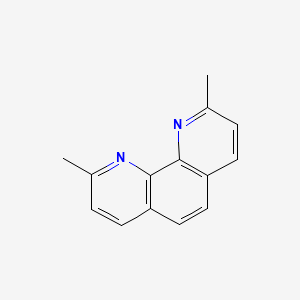
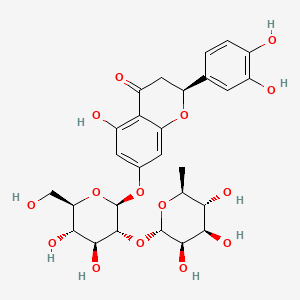
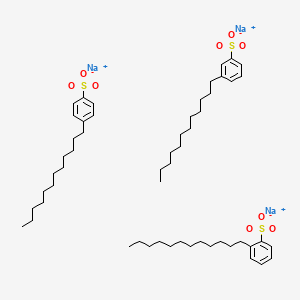
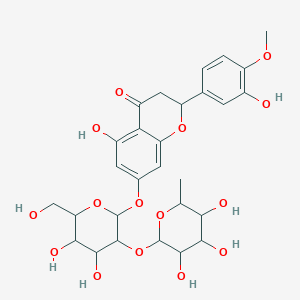

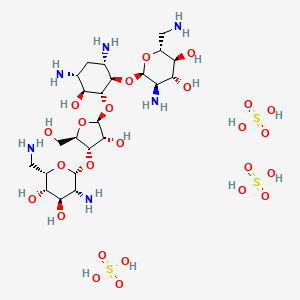
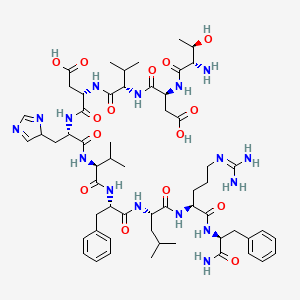
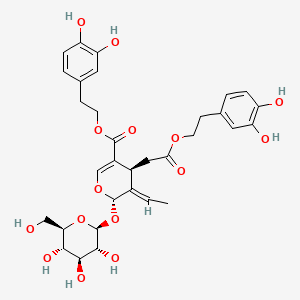
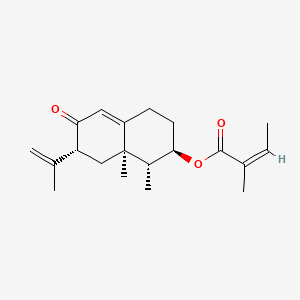

![[(11Z,13E)-6-[4-(dimethylamino)-3,5-dihydroxy-6-methyloxan-2-yl]oxy-10-[5-(dimethylamino)-6-methyloxan-2-yl]oxy-5-methoxy-9,16-dimethyl-2-oxo-7-(2-oxoethyl)-1-oxacyclohexadeca-11,13-dien-4-yl] propanoate](/img/structure/B1678178.png)
